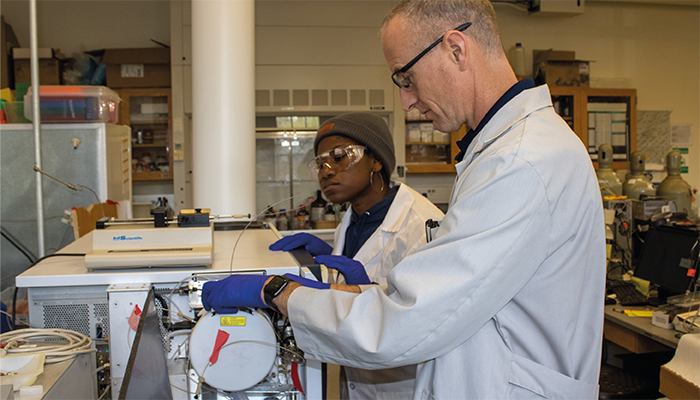Explore the latest breakthroughs in mass spectrometry, including a novel method for identifying tumor-specific neoepitopes, a GC-MS/MS workflow for detecting organochlorine pesticides, and advanced HPLC-Orbitrap MS techniques for screening new psychoactive substances

WVU doctoral student Alexandra Adeoye and forensic chemist Glen Jackson load a sample for analysis on a Q-TOF mass spectrometer, which measures the accurate mass of different drugs and their fragments. Credit: WVU Photo/Maddy Watson
US National Institute for Justice grants nearly $400,000 to West Virginia University to adapt current psychoactive substance (e.g. fentanyl) analysis techniques for tandem mass spectrometry – to be used in crime scene investigations. Link
A review of the changes and advancements in the development of multi-pass analyzers for time-of-flight mass spectrometry (TOF MS) over the past two decades, signaling faster detection rates and tighter beam compression as areas for improvements in multi-reflecting (MRT) technology. Link
Researchers use real-time library searches for glycoproteomic data acquisition for tandem mass spectrometry (MS/MS), observing site-specific characterization of both N- and O-glycopeptides relative to traditional methods for each. Link
An optimized workflow for multiplex DIA mass spectrometry combined with dynamic SILAC labeling (pSILAC) to measure protein turnover is introduced alongside KdeggeR: a new data processing package designed to visualize peptide and protein degradation rates. Link
A study from the Center for Genomic Regulation reveals how metabolic enzymes are able to inherit secondary functions within the nucleus; the researchers use mass spectrometry to characterize the MTHFD2’s nuclear interactome’s role regarding cell growth, as well as proper cell mitosis. Link
Comparisons of the proteomic and functional differences between human embryonic (hESCs) and induced pluripotent stem cells (hiPSCs) using LC-MS reveal potential risks and benefits for the latter’s use in future disease modeling and therapeutics. Link
Chewing the Fat
A Turn for the Better
A few weeks ago, we touched on a newly developed way to analyze protein complex dynamics, known as serial ultrafiltration combined with limited proteolysis coupled to mass spectrometry (FLiP-MS).
Our full interview with co-authors Cathy Marulli, Paola Picotti and Natalie de Souza on their findings is now live! Looking forward, they hope the method will be used to accumulate a library of protein-binding interfaces (PBIs), to better understand the effects mutations have in cancer and disease mechanisms.
“There is more and more literature showing that PPI networks largely rewire in human diseases, suggesting that targeting those interactions could be a therapeutic strategy. Our current study is in yeast, but can easily be implemented in a human system. Once we’ve done that, FLiP-MS has the throughput and scalability to, in principle, track changing PPIs across the human proteome in patient samples to pinpoint interactions dysregulated in a disease, possibly even in a personalized manner.”
Greatest Snow on Earth
A recent study has provided the best evidence yet in favor of the “Snowball Earth” theory – a concept proposing that the Earth was once covered in a thick layer of ice hundreds of millions of years ago.
Analyzing samples of sandstone ridges formed in Colorado’s Rocky Mountains using high-resolution laser ablation-inductively coupled plasma mass spectrometry (LA-ICP-MS), researchers were able to date (what they believe to be) remnants of subglacial meltwater events from the Sturtian glaciation.
"We want to get the word out so that others try and find these features and help us build a more complete picture of Snowball Earth," said co-author Liam Courtney-Davies in a press release. “We have to better characterize this entire time period to understand how we and the planet evolved together.”
Read the full story here!
Neither Fish nor Flesh
Until this week, I was not aware of the titan arum flower, commonly known as corpse flower – because its rare blooming scent is reminiscent of rotting flesh. This is despite having apparently seen one in the flesh – pun not intended – at London’s Kew gardens, which they say “attracts thousands of visitors hoping to experience the magnificent sight and disgusting stench.” Each to their own.
The corpse flower also draws the attention of curious scientists, interested in the genetic pathways and biological mechanisms that produce heat – unusual in plants – and the odorous chemicals. A Dartmouth-led study used RNA sequencing and mass spec to do just that. They identified a previously unrecognized component of the corpse flower’s odor: the appropriately named putrescine, derived from arginine.




